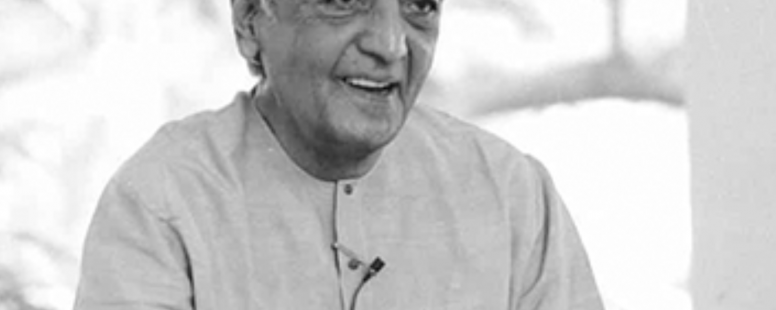Literature review on Learning Theory: About an education for life.
There are several different types of learning theories and theorists that exist and focus on different aspects of education. This literature review will explore the theory of Jiddu Krishnamurti (1935). For him, the role of teachers is to understand the challenges students meet on a personal level, including intellectually, socially and physically and also on a global scale (Morin, 1999) to assist them in becoming whole, compassionate and free. Learning in this context, doesn’t only depend on thoughts and mental constructions of new knowledge but also on the liberation of the mind, which makes this approach radically different from some other types of learning theory.
For the purpose of this literature review, the following will apply the theory to a school context and the 21st Century learner by using three-interdependent notions of awareness, responsibility and collaboration.
Jiddu Krishnamurti (1895-1986)
Presence and awareness is the first and main key factor for this type of learning. This relates to the individual living in the present moment, without being distracted by mental or emotional chatter connected to past, future or even present experiences (Norbu, 2013). Research has proven that learning is enhanced if individuals are fully engaged in the situation, therefore attentive and present (Le Pelley, Mitchell, Beesley, George & Wills, 2016). Further, full mindfulness will awaken the mind and increase one’s potential for this specific type of intelligence and decrease the likelihood of learning obstacles (Srinivasan, 2000). For example, this theory could be applied to a Health and Physical Education (HPE) class of judo, where students are exposed to this type of intelligence. After having mastered a few basic projection techniques during judo teaching, the students will use them more efficiently if they are fully aware and open to the diverse, unexpected reactions of the opponent. This notion of awareness can also be applied in a social context where a student is bullying others, awareness will help the student increase their sensitivity to their own and others’ emotions. By using this awareness, the student is more likely to see the outcome of their actions and to prevent them. Also, the bullied student will be able to use this skill to be fully aware of the conflict as it happens and not be overcome by fear.
Learning obstacles can be due to emotional states, such as fear, which steals the attention of the student (Freuerstein et al, 2010). Mindfulness has been largely recognised as a helpful factor in overcoming such mental states (Kirrikan, 2015) and a large amount of research in recent years on the introduction of mindfulness in the education space has supported the positive outcomes (Schonert-Reichl & Roeser, 2016; Ergas, 2017). This can be applied to an example of a HPE lesson of swimming where one of the students is afraid of the water, preventing him/her from learning how to swim. With awareness and mindfulness of his/her psychological processes, he/she could observe the illusion of his/her self-identity and his/her fear being just thoughts, enabling the fear to drop away effortlessly.

There exist, however, a few warnings in the literature prior to using mindfulness at this deeper level in education. First of all, teachers need to have an in-depth level of familiarity with such knowledge, which requires often years of training (Taylor, 2014). Secondly, teachers are limited in assessing progress and the support required for increasing self-awareness due to its internal nature. Thirdly, in order for such intelligence to ripen, the whole life environment of the student needs to encourage it, and often parents, principals or teachers are not valuing it in their own lives. Finally, it is very important that presence and awareness does not become a concept used by teachers to assert their power and authority over students. Instead it should be use as an additional tool in education to encourage the student to grow and be responsible for themselves.
Being responsible for oneself is another key point in education (Norbu, 1994) and in setting goals for quality learning. It means that the acquisition of knowledge and the capacity in feeling safe and complete becomes inherent in the individual and therefore external authority disappears (Pandey, 2013). Becoming responsible for oneself entails the individual seeing reality as it is and not becoming conditioned by beliefs, opinions or ideas. In Krishnamurti’s schools still existing in the 21st century, the two approaches of inquiry base learning (Berg, Bergendahl, Lundberg & Tibell, 2003) and project base learning (Blumenfeld et al, 1991) are used to help students approach facts and dissolve beliefs. The aim is to assist students take full responsibility for their learning by doing their own project through experience and often real-life application (Dewey, 1916). It also gives them confidence that observation, inquiry and the use of evidence can help them understand reality better. As an example, the Sport Education and Physical Education Program [SEPEP] (Callcott, Miller, Wilson-Gahan, 2015), which is project based, together with a cooperative learning approach (ibid) has successfully showcased this aspect of the theory. It could also be used in another example in which teachers organise a semester of dance based on the creation of choreographies in groups. The students would be given ten weeks to prepare their ‘body-movement stories’ and create their own learning program in order to present it in front of all school’s pupils, teachers and parents at the end of the semester. The teachers will overview the projects and offer support and structure when needed. The level of autonomy and creativity will help teachers resolve one of the most problematic challenging behaviour in [HPE] classes: disengagement, and increase responsibility (Oliveira, 2014). Having a project will motivate the student to set short and long-term goals based on their actual performance (Sinelnikov, 2007). Therefore, they learn how to look at the facts, what they are able to do concretely, and let go of their beliefs that they can or can’t do such movement. Once they become fully aware and responsible for their learning they are able to make decision to improve their skills based on evidence obtained. Self-assessment is also a means to increase learning potentiality (Khoiriyah, Roberts, Jorm & Van der Vleuten, 2015).
To become a fully free and responsible individual requires learning about ourselves so deeply that we understand our own learning process (Krishnamurti, 1953). The first step for teachers to ensure this occurs would be to help students gaining confidence in themselves by relying more and more on intrinsic feedback than extrinsic one feedback (Sullivan, Kantak & Burtner, 2008). Therefore, building up the capacity to observe for themselves their own thinking process too. Furthermore, there are many levels of depth in learning (Marzano & Kendall, 2007). Learning is not only memorising and repeating but also about dissolving preconceived ideas in order to have a fresh and open view of new ground (Treagust & Duit, 2012). Students today are facing a world of constant change, in which learning how to learn becomes more useful than learning a skill or knowledge. In a classroom, instead of analysing the process of learning mentally, we could train in just observing it inwardly. This way students will be able to see for themselves how precious learning is and how to best approach it.
Being responsible for oneself is not an easy process. This may vary for students as they might have different capacities in regard to dealing with self-monitored tasks. Secondly each student will find motivation in various ways while engaging in physical activities (Skoda, Doulík, Bílek & Šimonová, 2015). Therefore, it becomes the responsibility of the teacher to understand fully his students and to differentiate accordingly; which is a challenge in order to deliver all the content detailed in the Australian curriculum assessment and reporting authority [ACARA] (2018) to 30 different students per class (Perrenoud, 1995). Helping the student to be responsible and unconditioned by authority firstly requires the teacher to have this understanding themselves, which may be difficult for some to achieve that inner understanding. One of the most efficient ways to deal with these various obstacles might be to engage more deeply in communication and collaboration.

Collaboration and respecting other peoples’ dimension is not only an aim for educators, but also a mean to increase one’s learning capacities. Collaboration refers to the capacity to work together towards the same goal, while encouraging communication and self-awareness, while communication is a learning experience from one another until both are on the same page (Dewey, 1916; Spence, 2006). Therefore, learning implies that both the educator and the student place themselves on the same level, the former ensuring that no pressure or authority exists (Krishnamurti, 1953). Learning together within a non-hierarchical relationship, will promote a space of trust. By not being conditioned by mental concepts, the teacher is able to view the student without preconceptions. The teacher will be able to approach the learner with compassion, effortlessly creating peace and security in the relationship (Valdez, 2014). In this environment based on freedom and care, the student will be able to open to new knowledge more easily (Einstein & Born 1972; Montessori, 1948). Students today are noxiously affected by society’s pressure, including peers, parents, teachers and social structures (Hinshaw & Kranz, 2009). Symptoms such as anxiety and depression or even post-traumatic stress have a destructive impact on their capacity to learn (Freuerstein et al, 2010). Therefore, it is imperative that the role of the teacher is to drop any personal agenda or expectation in relation to the students (Gurmeet, 2015). This atmosphere based on compassion and freedom will foster a positive climate for collaboration and learning.
Collaboration is a creative process between various people, it therefore has a great potential for generating joy, happiness and self-fulfilment which can assist in reducing the likelihood of students experiencing boredom. Medina (2009) shows that boredom reduces attention quality and creates an impediment to the learning process. Collaboration is important because the experience and the desire of needs met will tend to motivate the learner intrinsically and enhance alertness during the learning process (Maslow, 1968). However, for joy to arise from collaboration, the participants need to put their own view aside in order to find harmonious solutions. Also, the vacuum of knowledge created by the group will enhance the understanding of everyone, known as the More Knowledgeable Other theory of Vygotsky (McLeod, 2014). Applying it into a soccer class for year nine, the teachers could create stations where students need to solve problems, such as how to get the ball on the other side in the safest way possible through various obstacles. Teachers then could ask the different teams to refrain from any communication before the actual task. This situation encourages the students to be more present in the situation and interact by using one another’s insights to solve the problem. The interaction between players becomes therefore somehow similar to the spontaneous intelligence born out of collaboration that we find in Jazz music. As collaboration is not a mechanical process of repetition and memorisation, but something happening from moment to moment, it requires a mind which is always new and fresh. This is the reason why collaboration enhances an intelligence beyond conceptual thinking.
The main obstacle for implementing collaboration with the intent of learning is the ability for the teacher to know themselves, having the capacity to look inward without creating fantasies about their own aptitude, which requires deep honesty (Bandura, 2003; Malhotra, 2018; Norbu, 2013). Through collaboration, students learn that freedom is not about doing whatever they like, but being able to act creatively with sensitivity, respecting oneself, others and the environment which assists them in developing a sense of beauty and contentment (Morin, 1999).

This literature review provided an overview of a theory of learning for students based on Jiddu Krishnamurti’s philosophy of education. We saw that on one side it is able to develop a new type of intelligence and on the other side able to enhance the capacity to develop more common domains of intelligence described by Gardner (2006).
Despite the difficulty in describing it due to its non-conceptual nature we discovered that the main aspect of this theory is to foster a type of awareness in which our past conditioning leaves a place for spontaneity, wisdom, freshness and beauty. In this way students can become responsible, collaborative and successful learners, able to meet the entirety of life’s challenges, of today and tomorrow. The main difficulty in applying it in the classroom is the high responsibility and involvement of teachers. While being able to convey the necessary curriculum content they have to live the same process of learning at the same time as the students, living and observing life as a whole, moment by moment. This is therefore a whole topic in itself, which could be dealt in Task three of this unit on ‘Quality Learning and Teaching’. Finally, to this date, no direct research has been known to address the entirety of this philosophy in regard to learning and the outcomes of such an approach for students. The lack of information greatly limited this literature review and illustrates the need for further research.
List of References
Australian Curriculum Assessment and Reporting Authority (ACARA) (2018). Australian Curriculum. Retrieved from the web site: https://www.australiancurriculum.edu.au
Bandura, A. (2003). Commmentary: “On the Psychosocial Impact and Mechanisms of Spiritual Modeling“. The International Journal for the Psychology of Religion, 13:3, 167-173, DOI: 10.1207/S15327582IJPR1303_02
Berg, C.A.R., Bergendahl, V.C.B., Lundberg, B.K.S. & Tibell, L.A.E., (2003). “Benefiting from an open-ended experiment? A comparison of attitudes to, and outcomes of, an expository versus an open-inquiry version to the same experiment”. International Journal of Science Education. 25 (3): 351372. DOI:10.1080/09500690210145738.
Blumenfeld et al 1991, EDUCATIONAL PSYCHOLOGIST, 26(3&4) 369-398 “Motivating Project-Based Learning: Sustaining the Doing, Supporting the Learning.” Journal Educational Psychologist – Issue 3-4. DOI:10.1080/00461520.1991.9653139
Callcott, D., Miller, J., & Wilson-Gahan, S. (2015). Health and physical education: preparing educators for the future. Cambridge University Press.
Dewey, J. (1916). Democracy and Education. New York: Macmillan
Einstein, A. & Born, M. (1972). Correspondance, 1916-1955. Paris: Seuil
Ergas, O. (2017). Reconstructing ‘Education’ through Mindful Attention: Positioning the Mind at the Center of Curriculum and Pedagogy. London: Springer Nature
Feldenkrais, M. (1972). Awareness Through Movement: Health Exercises for Personal Growth. London: Harper and Row
Feuerstein R., Feuerstein R. & Falik L.H. (2010). Beyond Smarter: Mediated Learning and the Brain’s Capacity for Change. New York: Teacher College Press
Gardner, H. (2006). Multiple Intelligence. New York: Basic Books.
Gurmeet, K. (2015) Educational thoughts of J Krishnamurti and their relevance to present education. Kumaun University: Department of education. Retrieved from: http://hdl.handle.net/10603/43710
Hinshaw, S., Kranz, R. (2009). The Triple Bind: Saving Our Teenage Girls from Today’s Pressures. Random House Publishing Group
Kallipiran, K., Koo, S., Kirubakaran, R., Hancock, K. (2017). Review: Effectiveness of mindfulness in improving mental health symptoms of children and adolescents: a meta‐analysis. Journal of School Psychology, August 2017, pp.77-103.
Khoiriyah, U., Roberts, C., Jorm, C. & Van der Vleuten, C. P. M., (2015). Enhancing students’ learning in problem-based learning: validation of a self-assessment scale for active learning and critical thinking. BMC Medical Education, 15 (1):140 DOI:10.1186/s12909-015-0422-2
Krishnamurti Foundation India. (2017). Portrait. Retrieved from the web site: http://www.kfionline.org.
Krishnamurti, J. (1956). Education and the significance of life, New-York: HaperCollins publishers
Krishnamurti, J. (1993). A Flame of Learning, Krishnamurti with teachers. Chennai: Krishnamurti Foundation India.
Le Pelley, M. E., Mitchell, C. J., Beesley, T., George, D. N., & Wills, A. J. (2016). Attention and associative learning in humans: An integrative review. Psychological Bulletin, 142(10), DOI:10.1037/bul0000064
Malhotra, M. (2018). Relevance of Educational Contribution Of Jiddu Krishnamurti In The Present System Of Education. International Journal of Scientific Research and Management, 6(01).
Marzano, R.J. Kendall J.S. (2007). The New Taxonomy of Educational Objectives. Thousand Oaks: Corwin Press.
Maslow, A.H. (1968). Towards a psychology of Being. New York: Van Nostrand.
McLeod, S. A. (2014). Lev Vygotsky. Retrieved from www.simplypsychology.org/vygotsky.html
Medina, J. (2009). Brain rules, 12 principles for surviving and Thriving at Work, Home and School. Seatle: Pearpress.
Montessori, M. (1989). To Educate the Human Potential. Santa Barbara: ABC-CLIO
Morin, E. (1999). Seven Complex Lessons for the Education of the Future. Paris: UNESCO
Norbu, C. N. (1994). The Real Meaning of Integration, Educating children, Newcomers, The Dzogchen Community. Arcidosso: Shang Shung Edizioni.
Norbu, C. N. (2013). The Mirror: Advice on Presence and Awareness (dran pa dang shes bzhin gyi gdams pa me long ma). Religions, 4(3), 412-422.
Oliveira, N. M. (2014). Teachers’ experiences with disengagement in physical education classes at secondary school level in the Perth Metropolitan Area. Retrieved from http://ro.ecu.edu.au/theses/1274
Pandey, P. S. (2013). J. Krishnamurti’s right education. Educational Quest: An International Journal of Education and Applied Social Sciences 4(3), p.207-212
Schonert-Reichl K.A. Roeser R.W. (2016). Handbook of Mindfulness in Education: Integrating Theory
and Research into Practice. New York: Springer.
Perrenoud, P. (1995). La pédagogie à l’école des différences. Paris: ESF.
Skoda, J., Doulík P., Bílek M., Šimonová I. (2015). The effectiveness of inquiry-based science education in relation to the learners’ motivation types. Journal of Baltic Science Education, 14 (6).
Sinelnikov, O. A. (2007). Teaching and learning how to teach Sport Education: An ecological analysis, motivational climate and professional development. Auburn University.
Spence, Muneera U. (2006) “Graphic Design: Collaborative Processes = Understanding Self and Others.” (lecture) Art 325: Collaborative Processes. Fairbanks Hall, Oregon State University.
Srinivasan, T.S. (2000). J.Krishnamurti and the Practice of Management.Vision. The journal of Business perspective. Special issue pp52-56.
Sullivan, K.J., Kantak, S. S., & Burtner, P. A. (2008). Motor learning in children feedback effects on skill acquisition. Physical Therapy, 88(6), 720-732
Taylor’s 7th Teaching and Learning Conference. (2014). Proceedings Holistic Education: Enacting Change. Singapore: Springer
Treagust, D. Duit, R. (2012). Conceptual Change Learning and Teaching, “The Art of Teaching Science for middle and secondary school”. Sydney: Allen & Unwin.
Valdez, M.L.A. (2014). Teachings on Peace of the 14th Dalai Lama and Selected Literary Philosophers: Implications for Global Peace Education. Asia Pacific Journal of Multidisciplinary Research 2(3), 89-85.
